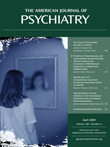Psychiatric Disorders and Repeat Incarcerations: Is There an Epidemic?
To the Editor: In their article on mentally ill prisoners and repeat incarceration, Dr. Baillargeon et al. (1) stated that “the epidemic of psychiatric disorders in the U.S. prison system represents a national public health crisis” ( 1 , p.103). One of the explanations the authors presented was that of an influx of psychiatric patients into the prison system following the mass closures of state hospitals that began in the 1960s. However, the data they provided for Texas inmates do not appear to support this argument.
Dr. Baillargeon et al. did not calculate prevalence rates. However, they reported schizophrenia in 849 out of 79,211 inmates and nonschizophrenia psychotic disorder in 1,375 inmates, which results in rates of 1.1% and 1.7%, respectively. This is similar to the U.S. adult civilian population, in which rates for schizophrenia are reported in the 1% to 2% range (2) . The vast majority of long-term patients in state hospitals (76% in one study) have schizophrenia and other nonaffective psychotic disorders (3) . Consequently, if there was a significant transfer of patients from state hospitals to prisons, rates for these disorders should be higher.
Bipolar and major depressive disorders were found in 3% and 4.1%, respectively, of Texas inmates in the Baillargeon et al. study, which is also comparable with studies of civilian populations, especially when corrected for inmate sociodemographic factors. Inmates are largely individuals from lower socioeconomic groups, and a socioeconomic downward drift can result in rates of psychiatric disorders in the lowest socioeconomic classes that are several times higher than in the highest socioeconomic classes (4) .
Serious mental disorders (major depressive disorder, bipolar disorder, schizophrenia, and nonschizophrenia psychotic disorder) were found in 9.9% of Texas inmates. As the authors pointed out, other studies have reported serious mental disorders in 15% to 24% of U.S. inmates ( 1 , p.103). If the data reported by Dr. Baillargeon et al. are valid, then the Texas correctional system does not appear to have the “epidemic” of mentally ill prisoners found elsewhere. Another possibility is that errors in data collection and interpretation led to lower than actual rates for schizophrenia and other disorders.
1. Baillargeon J, Binswanger IA, Penn JV, Williams BA, Murray OJ: Psychiatric disorders and repeat incarcerations: the revolving prison door. Am J Psychiatry 2009; 166:103–109Google Scholar
2. Robins LN, Helzer JE, Weissman MM, Orvaschel H, Gruenberg E, Burke JD, Regier DA: Lifetime prevalence of specific psychiatric disorders in three sites. Arch Gen Psychiatry 1984; 41:949–958Google Scholar
3. Fisher WH, Barreira PJ, Geller JL, White AW, Lincoln AK, Sudders M: Long-stay patients in state psychiatric hospitals at the end of the 20th century. Psychiatr Serv 2001; 52:1051–1056Google Scholar
4. Neugebauer R, Dohrenwend BP, Dohrenwend BS: Formulation of hypotheses about the true prevalence of functional psychiatric disorders among adults in the United States, in Mental Illness in the United States: Epidemiological Estimates. Edited by Dohrenwend BP, Dohrenwend BS, Gould MS, Link B, Neugebauer R, Wunsch-Hitzig R. New York, Praeger, 1980, pp 45–67Google Scholar



